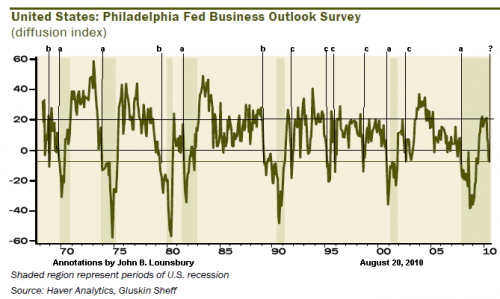What Does the Philly Fed Contraction Signal Really Mean?
By John Lounsbury
David Rosenberg, chief economist for Toronto’s Gluskin Sheff, has a graph showing the history of the Philly Fed Business Outlook Survey. I have added annotations below:
Before this month and since 1968 there have been 13 times the index has fallen from 20 or higher to -7, the current reading. The 13 occasions can be divided into three classes:
a. 5 times a recession was underway or would start within 3 months.
b. 3 times a recession started within 2 years. All 3 signals occurred before 1990.
c. 5 times were a false alarm for recession. All five false alarms occurred after 1990.
Now we have the 14th signal. What does it mean? Probably not much in and of itself. Here are my reasons:
- There were similar dips within a year of the end of the two preceding recessions.
- Since 1990 this signal has only had a 29% success rate in calling a recession.
- Even if the index were to fall twice as far below neutral (-14) the success rate in calling a recession only improves to 33%.
- All 8 of the successful signals saw the index eventually fall to below -30, so there is nothing magical about the magnitude of -7.
But this signal can not be considered in a vacuum. With other factors considered, such as the rapidly contracting expectation for GDP growth, the persistent high level of unemployment, rising weekly initial unemployment claims, the historically long mean duration of unemployment, declining or rolling over leading economic indicators and a fragile housing market, this signal of contraction can not be dismissed.
In and of itself the Philly Business Outlook number is not that serious. In the context of other worrisome economic weakness it is more problematic.

Spinmeister!!!
I think the correct spin is:
1. A fall below -7 doesn’t mean recession is imminent when you look at historical data.
2. In the past, one reason the economy didn’t double dip is that the Fed goosed the economy through lower interest rates.
3. Rates are as low as they can go today.
4. So a fall of this magnitude SHOULD make you worried about an eventual double dip.